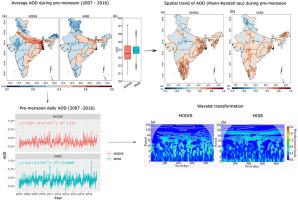当前位置:
X-MOL 学术
›
J. Atmos. Sol. Terr. Phys.
›
论文详情
Our official English website, www.x-mol.net, welcomes your feedback! (Note: you will need to create a separate account there.)
A synergy of linear model and wavelet analysis towards space-time characterization of aerosol optical depth (AOD) during pre-monsoon season (2007–2016) over Indian sub-continent
Journal of Atmospheric and Solar-Terrestrial Physics ( IF 1.9 ) Pub Date : 2020-12-01 , DOI: 10.1016/j.jastp.2020.105478 Gunadhar Barik , Prasenjit Acharya , Arabinda Maiti , Bijoy Krishna Gayen , Somnath Bar , Ashis Sarkar
Journal of Atmospheric and Solar-Terrestrial Physics ( IF 1.9 ) Pub Date : 2020-12-01 , DOI: 10.1016/j.jastp.2020.105478 Gunadhar Barik , Prasenjit Acharya , Arabinda Maiti , Bijoy Krishna Gayen , Somnath Bar , Ashis Sarkar

|
Abstract The pre-monsoon aerosol concentration plays a significant role in modifying precipitation amount over the Indian sub-continent. A large variety of aerosol from different sources produces a complex radiative and climate response through the interaction with the hydrometeorological parameters. In this study, we analyzed the space-time dynamics of aerosol optical depth (AOD) in relation to the meteorological and surface parameters over Indian sub-continent during pre-monsoon season from 2007 to 2016. The level-3 daily aerosol products from Moderate Resolution Imaging Spectroradiometer (MODIS) and Multi-angle Imaging Spectroradiometer (MISR) were used. The IMD gridded rainfall and temperature, ECMWF derived RH and wind velocity, and GLADS derived soil moisture data were also used at daily time scale. For the space-time model, the Mann-Kendall trend test and a pixel-based multiple linear regression were used, while, wavelet transformation was used on these daily observations for analyzing periodicities of AOD. The time-series average shows moderate to high AOD (0.4–0.8), including a consistent positive anomaly in the Indo-Gangetic basin (IGP) in north India. A significant inter-annual variation is also observed both in MODIS and MISR datasets. The trend statistics shows an increasing trend of aerosol concentration in the eastern and southern India. The linear regression shows a variable response of AOD with changing magnitude of meteorological factors. However, a substantial spatial coverage of significantly decreased AOD is observed with increasing soil moisture content (β
中文翻译:

线性模型和小波分析对印度次大陆前季风季节(2007-2016)气溶胶光学深度(AOD)时空表征的协同作用
摘要 季风前气溶胶浓度在改变印度次大陆降水量方面起着重要作用。来自不同来源的大量气溶胶通过与水文气象参数的相互作用产生复杂的辐射和气候响应。在这项研究中,我们分析了 2007 年至 2016 年季风季前印度次大陆上与气象和地表参数相关的气溶胶光学深度 (AOD) 的时空动态。使用分辨率成像光谱仪(MODIS)和多角度成像光谱仪(MISR)。IMD 网格降雨和温度、ECMWF 派生的 RH 和风速以及 GLADS 派生的土壤水分数据也用于每日时间尺度。对于时空模型,使用 Mann-Kendall 趋势检验和基于像素的多元线性回归,同时对这些日常观察使用小波变换来分析 AOD 的周期性。时间序列平均值显示中到高 AOD (0.4-0.8),包括印度北部印度-恒河盆地 (IGP) 的一致正异常。在 MODIS 和 MISR 数据集中也观察到显着的年际变化。趋势统计表明,印度东部和南部的气溶胶浓度呈上升趋势。线性回归显示了 AOD 随气象因素大小变化的可变响应。然而,随着土壤水分含量的增加(β 在这些日常观察中使用小波变换来分析 AOD 的周期性。时间序列平均值显示中到高 AOD (0.4-0.8),包括印度北部印度-恒河盆地 (IGP) 的一致正异常。在 MODIS 和 MISR 数据集中也观察到显着的年际变化。趋势统计表明,印度东部和南部的气溶胶浓度呈上升趋势。线性回归显示了 AOD 随气象因素大小变化的可变响应。然而,随着土壤水分含量的增加(β 在这些日常观察中使用小波变换来分析 AOD 的周期性。时间序列平均值显示中到高 AOD (0.4-0.8),包括印度北部印度-恒河盆地 (IGP) 的一致正异常。在 MODIS 和 MISR 数据集中也观察到显着的年际变化。趋势统计表明,印度东部和南部的气溶胶浓度呈上升趋势。线性回归显示了 AOD 随气象因素大小变化的可变响应。然而,随着土壤水分含量的增加(β 包括印度北部印度恒河盆地 (IGP) 的一致正异常。在 MODIS 和 MISR 数据集中也观察到显着的年际变化。趋势统计表明,印度东部和南部的气溶胶浓度呈上升趋势。线性回归显示了 AOD 随气象因素大小变化的可变响应。然而,随着土壤水分含量的增加(β 包括印度北部印度恒河盆地 (IGP) 的一致正异常。在 MODIS 和 MISR 数据集中也观察到显着的年际变化。趋势统计表明,印度东部和南部的气溶胶浓度呈上升趋势。线性回归显示了 AOD 随气象因素大小变化的可变响应。然而,随着土壤水分含量的增加(β
更新日期:2020-12-01
中文翻译:

线性模型和小波分析对印度次大陆前季风季节(2007-2016)气溶胶光学深度(AOD)时空表征的协同作用
摘要 季风前气溶胶浓度在改变印度次大陆降水量方面起着重要作用。来自不同来源的大量气溶胶通过与水文气象参数的相互作用产生复杂的辐射和气候响应。在这项研究中,我们分析了 2007 年至 2016 年季风季前印度次大陆上与气象和地表参数相关的气溶胶光学深度 (AOD) 的时空动态。使用分辨率成像光谱仪(MODIS)和多角度成像光谱仪(MISR)。IMD 网格降雨和温度、ECMWF 派生的 RH 和风速以及 GLADS 派生的土壤水分数据也用于每日时间尺度。对于时空模型,使用 Mann-Kendall 趋势检验和基于像素的多元线性回归,同时对这些日常观察使用小波变换来分析 AOD 的周期性。时间序列平均值显示中到高 AOD (0.4-0.8),包括印度北部印度-恒河盆地 (IGP) 的一致正异常。在 MODIS 和 MISR 数据集中也观察到显着的年际变化。趋势统计表明,印度东部和南部的气溶胶浓度呈上升趋势。线性回归显示了 AOD 随气象因素大小变化的可变响应。然而,随着土壤水分含量的增加(β 在这些日常观察中使用小波变换来分析 AOD 的周期性。时间序列平均值显示中到高 AOD (0.4-0.8),包括印度北部印度-恒河盆地 (IGP) 的一致正异常。在 MODIS 和 MISR 数据集中也观察到显着的年际变化。趋势统计表明,印度东部和南部的气溶胶浓度呈上升趋势。线性回归显示了 AOD 随气象因素大小变化的可变响应。然而,随着土壤水分含量的增加(β 在这些日常观察中使用小波变换来分析 AOD 的周期性。时间序列平均值显示中到高 AOD (0.4-0.8),包括印度北部印度-恒河盆地 (IGP) 的一致正异常。在 MODIS 和 MISR 数据集中也观察到显着的年际变化。趋势统计表明,印度东部和南部的气溶胶浓度呈上升趋势。线性回归显示了 AOD 随气象因素大小变化的可变响应。然而,随着土壤水分含量的增加(β 包括印度北部印度恒河盆地 (IGP) 的一致正异常。在 MODIS 和 MISR 数据集中也观察到显着的年际变化。趋势统计表明,印度东部和南部的气溶胶浓度呈上升趋势。线性回归显示了 AOD 随气象因素大小变化的可变响应。然而,随着土壤水分含量的增加(β 包括印度北部印度恒河盆地 (IGP) 的一致正异常。在 MODIS 和 MISR 数据集中也观察到显着的年际变化。趋势统计表明,印度东部和南部的气溶胶浓度呈上升趋势。线性回归显示了 AOD 随气象因素大小变化的可变响应。然而,随着土壤水分含量的增加(β



























 京公网安备 11010802027423号
京公网安备 11010802027423号